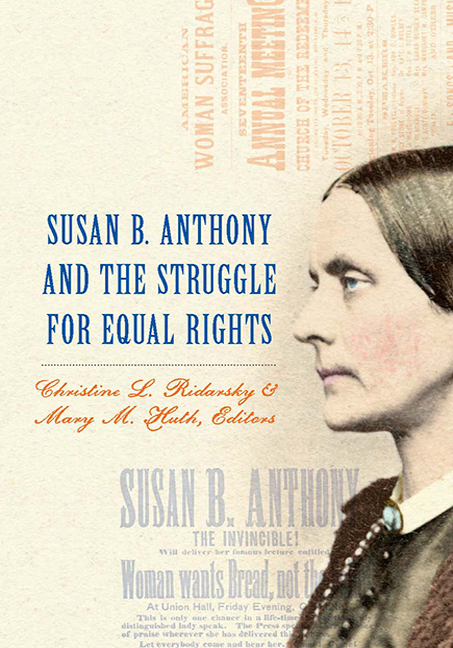Introduction
Published online by Cambridge University Press: 09 May 2017
Summary
When most Americans think about Susan B. Anthony and the struggle for equal rights, they focus on the battle for the Nineteenth Amendment to the US Constitution (1920) guaranteeing woman suffrage. Yet campaigns for equal rights extended across the nineteenth century and beyond the voting booth to religious institutions, the workplace, the home, and other sites of gender inequality. Moreover, the battle for suffrage itself unfolded in multiple arenas and was shaped by race, nationality, region, and class, as well as gender. In the 1840s and 1850s, for instance, Susan B. Anthony advocated for women's rights in temperance societies and state teachers’ conventions and fought for the abolition of slavery by emphasizing the cruelty visited on enslaved women. In the post–Civil War period, she demanded women's access to jobs outside their prescribed sphere, ranging from typesetters to ministers, and argued vociferously for their personal, economic, and political independence. Alongside these campaigns, she fought tirelessly for woman suffrage, believing that the vote symbolized true citizenship and that electoral power would advance equality in other arenas. She also collaborated on the multivolume History of Woman Suffrage, an effort to document the movement for equal rights, especially women's right to vote. The seven essays collected here trace the complex struggles for equal rights during Anthony's lifetime, the ways that Anthony helped shape those struggles along with our memories of them, and the process by which she became a symbol for political constituencies on the left and the right in the century since her death.
In recent decades, historians have documented myriad paths to women's advancement and gender equality. They have examined the ways that region, race, religion, and ethnicity have shaped battles for suffrage; campaigns to advance women's roles in churches, reform societies, labor unions, and the home; and debates over historical events and popular memory. These studies illustrate the uneven progress in efforts to achieve women's rights and the challenges posed by competing concepts of equality. This volume extends these analyses in new directions. It is framed by two essays that explore the politics of history and memory, opening with an analysis of how Anthony sought to capture her version of the women's rights movement for future generations, and closing with an exploration of how scholars and activists have wielded Anthony's life story over the past century.
Information
- Type
- Chapter
- Information
- Susan B. Anthony and the Struggle for Equal Rights , pp. 1 - 12Publisher: Boydell & BrewerPrint publication year: 2012
